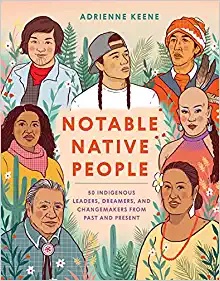Notable Native People: 50 Indigenous Leaders, Dreamers and Changemakers from Past and Present
Genre: biographies

Author: Adrienne Keene
Publisher: Ten Speed Press
An accessible and educational illustrated book profiling 50 notable American Indian, Alaska Native and Native Hawaiian people, from NBA star Kyrie Irving of the Standing Rock Lakota to Wilma Mankiller, the first female principal chief of the Cherokee Nation.
Celebrate the lives, stories and contributions of Indigenous artists, activists, scientists, athletes and other changemakers in this beautifully illustrated collection. From luminaries of the past, like nineteenth-century sculptor Edmonia Lewis—the first Black and Native American female artist to achieve international fame—to contemporary figures like linguist jessie little doe baird, who revived the Wampanoag language, Notable Native People highlights the vital impact Indigenous dreamers and leaders have made on the world.
This powerful and informative collection also offers accessible primers on important Indigenous issues, from the legacy of colonialism and cultural appropriation to food sovereignty, land and water rights, and more. An indispensable read for people of all backgrounds seeking to learn about Native American heritage, histories and cultures, Notable Native People will educate and inspire readers of all ages.
This collection of profiles is so focused on being diverse in both era and character (from a medicine man born in 1630 to a drag-queen basket-maker born in 1988) that it makes for strange bedfellows. Readers are not likely to have heard of many of the subjects, but then that’s part of the point. The illustrations are interesting and colorful, if also unflattering for framing subjects from the stomach up. The writing is fine and the six sidebars (Settler Colonialism 101, Whose Land Are You On?, Who Belongs, Representation Matters, Hawaii and Alaska, Current Issues in Indian Country) are particularly informative. Females significantly outnumber males (plus two nonbinary individuals), and Alaska, Hawaii and South Dakota are curiously overrepresented, but still, this book is valuable for offering role models to today’s young Indigenous people, and history and perspective needed by non-Indigenous youth.
- Pam Withers
no-repeat;left top;; auto
